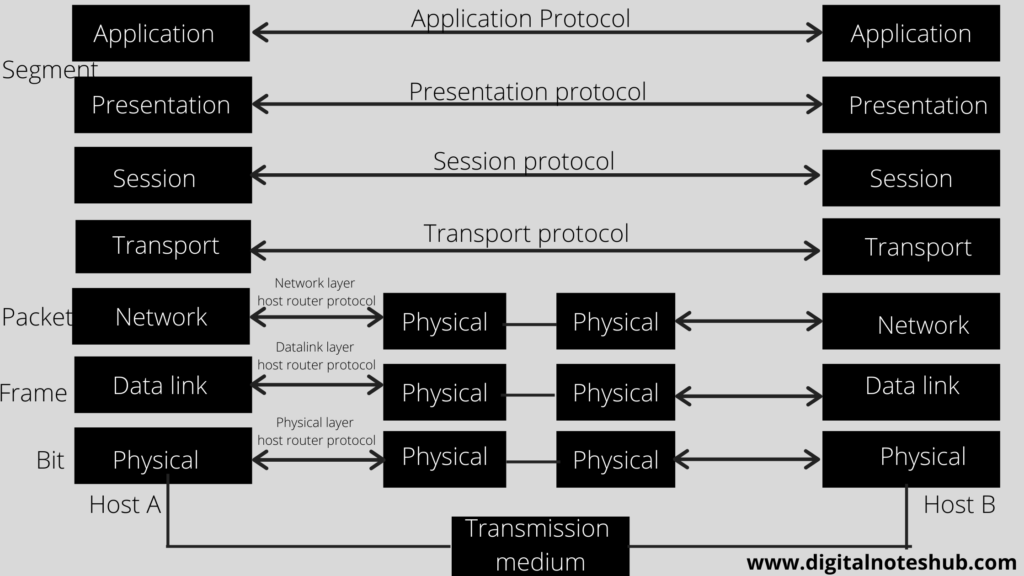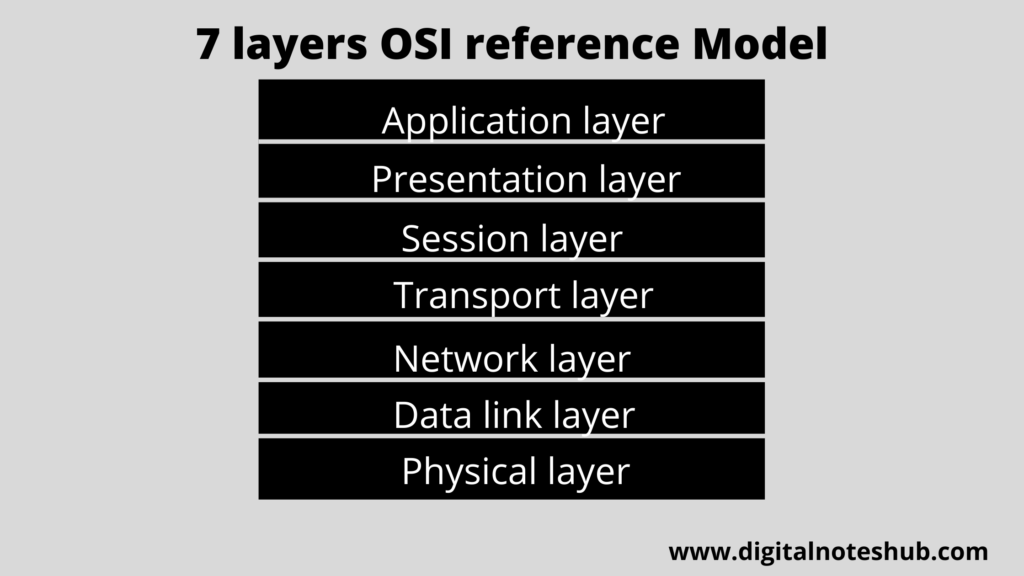
In this guide to computer networks, you’re going to explore OSI model layers explanation with proper diagrams and examples.
Let’s get started, happy learning!
What is OSI Model in Computer networks?
The full form of OSI is Open Source Systems, and it is developed by ISO(International Standard Organization). It is a 7 layer model and each layer of OSI has its own functionality. All the layers work together to send data from one host to another.
OSI model is not a protocol, but it is a model for understanding and designing a network architecture. We also called it as ISO-OSI reference model or OSI 7 layer model. OSI model deals with open systems and it means the systems which are open for communication with other systems.
OSI Model Diagram
The following is the OSI model diagram that shows the OSI 7 layer model, layers explanation and data flow between these layers.

OSI Model Layers Explanation
OSI Model is comprised of seven different layers. Basically, there are three types of layers: hardware layer, software layer and heart of OSI layers model. The following are the 7 layers of OSI Model.
- Physical Layer
- Datalink Layer
- Network Layer
- Transport Layer
- Session Layer
- Presentation Layer
- Application Layer.

Physical Layer
The lowest layer of the OSI reference model is the physical layer. At this layer, the information is in the form of bits and it is a hardware layer. The following are the primary functions of the physical layer.
- To activate, maintain, and deactivate the physical connection.
- It defines voltages and data rates needed for transmission.
- It converts the digital bits into the electronic signal.
- It decides whether the transmission is simplex, half-duplex or full-duplex.
Datalink Layer
The data links layer is also the hardware layer, and information at this layer is in the form of frames. It defines the format of data and the following are the major functions of the data link layer.
- The major function of the data link layer is synchronization.
- It is used for error detection and removal of the error.
- Encoded data is passed by a data link layer to the physical layer.
- It divides an outgoing message into frames.
Network layer
The layer between the data link and transport layer is called the network layer in the OSI model. It is one of the hardware OSI layers. It works for the data transmission from one host to another. The following are the primary functions of the network layer.
- It routes the signal and selects the shortest path for a packet.
- It acts as a network controller.
- It divides the outgoing messages into packets.
- It places the IP address of the sender and receiver in the header.
Transport layer
The transport layer is in between the session and the network layer of the OSI model. It is called the heart of OSI. The delivery of a message is the responsibility of the transport layer. The data is in the form of segments at this layer and the following are the primary functions of a transport layer.
- It decides the data transmission path, whether it should be parallel or single path.
- It does the functions of multiplexing, splitting or segmenting on the data.
- The transport layer guarantees the transmission of data from one end to another.
- It divides the outgoing message into segments.
Session layer
The session layer is the fifth layer of the OSI reference model and it is one from software layers of OSI. It handles the sessions and the following are the principal functions of the session layer.
- It manages and synchronizes conversations between the two different layers.
- It controls logging on and off and manages authentication.
- It controls billing and session management.
Presentation layer
The presentation layer is also known as the translate layer and it handles the translation of data. It makes sure that the information is delivered in such a form that the receiving system can understand easily and use it.
The following are the major functions of the presentation layer.
- It provides the translation from ASCII to EBCDIC.
- It converts the encrypted data into plain text and vice versa.
- It also compresses the size of a segment.
Application layer
The top layer of the OSI reference model is called the application layer. This layer is used to display the information to the user. It is also called a desktop layer.
The following are the major functions of an application layer.
- It provides different services, such as the manipulation of information.
- It re-transfers the files of information and distributes the results.
- The application layer also performs functions, such as login or password checking.
Merits of OSI Reference Model
There are various advantages to this model. The following are the main merits of an OSI reference model.
- It distinguishes clearly between the services, interfaces, and protocols.
- The protocols in the OSI Model are better hidden, and new protocols can easily replace them as technology changes.
- OSI model is truly a general model. This model supports connection-oriented as well as connectionless services.
Demerits of OSI 7 layer Model
The session and presentation layers are not of much use. This model was devised before the protocols were invented. So, in real life, there is a problem with fitting protocol into a model.
What are your thoughts?
Have you enjoyed this tutorial on OSI model layer explanation and if you have any queries feel free to ask in the comment section.
Additional Notes
- What is a point to point and multi-point connection.
- What are network topologies and their types?
- Computer networks and their types (LAN, MAN and WAN)
